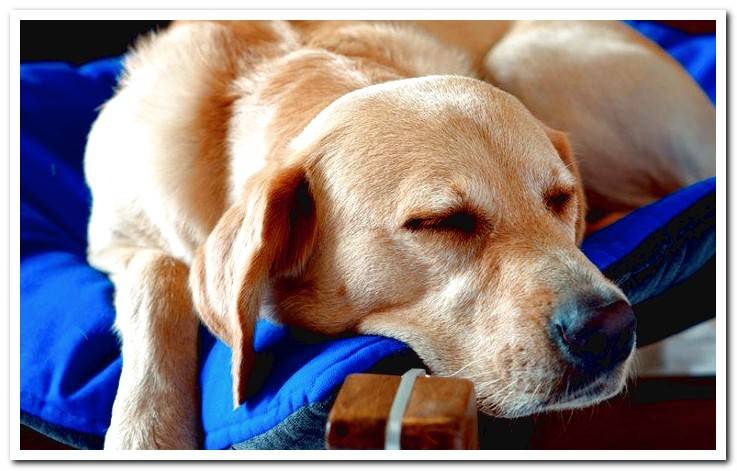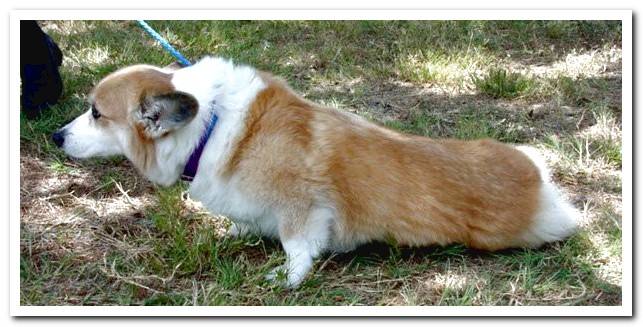
Degenerative myelopathy is an inherited disease of the nervous system. Its main symptom is a weakness in the hind legs that gradually spreads, complicating the picture.
Unfortunately, there is no treatment to cure degenerative myelopathy. But we can follow a series of recommendations to maintain the quality of life of the affected dog as much as possible. Do you want to know all the details about this disease?
Index of contents
- 1 What is degenerative myelopathy?
- 2 What are the symptoms of degenerative myelopathy?
- 3 Which dogs suffer from degenerative myelopathy?
- 4 Diagnosis of degenerative myelopathy
- 5 What is the treatment for degenerative myelopathy?
- 5.1 Rehabilitation and physiotherapy
- 6 Home care for a dog with degenerative myelopathy
What is degenerative myelopathy?
Is about a neurological degenerative disease. It affects the spinal cord and is transmitted within families. It has been compared with amyotrophic lateral sclerosis that humans can suffer.. What degenerates is the so-called white matter of the medulla and nerves.
This it damages the transmission of movement orders from the brain to the extremities and the sensory information that these send to the brain. It is not a very painful disease, but the pain ends up appearing in the parts of the body that are forced in an attempt to compensate for the immobility of the affected areas.
What are the symptoms of degenerative myelopathy?
The most common is weakness in the hind legs. This weakness progresses slowly. Paralysis and loss of sensation can also be seen in those same legs. This painting causes the dog to roam in an unstable, strange way, it drags its paws, badly supports its feet and falls.
The abnormal position that the legs acquire causes the nails to be dragged along the ground. So, Another sign that can make us suspect degenerative myelopathy is observing the most worn nails of the hind legs.. Being progressive, it can start with one rear leg, continue with the other and advance to the front limbs.
In this situation we will notice a general weakness, to the point that the dog will have a hard time standing up. Urination and defecation are affected. Incontinence appears. The progression of the disease ends up causing death. Complications such as pressure ulcers or urine infections can occur.

Which dogs suffer from degenerative myelopathy?
The symptoms of this disease appear, above all, in the German Shepherd. Myelopathy occurs in middle-aged specimens, generally from the age of eight. In this breed this type of myelopathy is the most common cause of weakness in the hind limbs.
To a lesser extent, It also affects the Siberian Husky, the Belgian Shepherd, the Collie, the Rottweiler, the Boxer, the Great Dane and, in general, large breeds.. Sick specimens are both male and female. Anyway, this myelopathy can appear in any other breed and also in mixed breed dogs.
Diagnosis of degenerative myelopathy
The vet will diagnose this myelopathy after ruling out other diseases that can trigger similar symptoms, such as herniated discs or tumors. Se uses tests such as x-rays, computed tomography, magnetic resonance imaging, or myelography.
What is the treatment for degenerative myelopathy?
Unfortunately, there is no treatment that can stop degeneration. Yes, measures can be implemented to maintain, as much as possible, the quality of life. Drugs have been used to try to recover sick specimens. But it has not been possible to improve the picture. Specifically, corticosteroids and vitamin supplements have been administered without success.
On the other hand, in some cases some improvement has been found with the administration of aminocaproic acid. It can occur with food. Rehabilitation and physical therapy are also recommended to try to delay degeneration as much as possible.
Rehabilitation and physiotherapy
It is aimed at improving the muscular tension that may appear, the loss of muscle and ulcers, as well as preserving mobility and balance to the maximum. All this is achieved with passive mobilization exercises, massages, stretching, heat, hydrotherapy or electrostimulation.
Of course, they are techniques that a specialized veterinaryn must perform. To help the dog to walk we can use harnesses. They are available for rear legs or for the support of the whole body. Some dogs will need a wheelchair to get around.
The earlier treatment is started, the better results can be seen. Untreated dogs perish before the year. Those who are well cared for increase their life expectancy to three.
Home care for a dog with degenerative myelopathy
In addition to the guidelines for exercises and utensils mentioned in the previous section, these dogs need a bed or a comfortable place to rest. The bed has to be fluffy but firm enough at the same time.
This is essential so that the dog can well support the paws on it when getting up. If the dog drags its paws, it is a good idea to protect your feet with special shoes for dogs, patuco or sock type.
In the most serious cases in which the dog hardly moves, it is essential to change his posture to avoid the formation of pressure ulcers in the support areas. It is necessary to watch that it is fed with correction, first to avoid the overweight and, later, to maintain the muscular mass.
